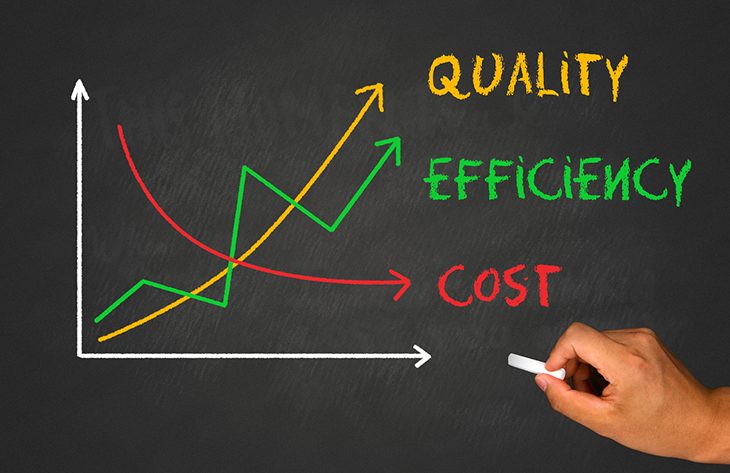What’s Your True Cost?
Control your business by looking on your own plate.

As a small child, whenever I wanted to go somewhere or do something my mother didn’t approve of, I would argue that all my friends were going to, or doing that activity. In quick response, regarding going somewhere, she would say, “If your friends jumped off a bridge, would you follow them?” Regarding activities she didn’t approve of, she would say, “Keep your eyes on your own plate.” The former was due to her concern about my safety. The latter was meant to show me that it was more important to be concerned about my business rather than that of someone else.
So often in our industry, contractors charge based on the amount competitors charge, or a dollar less. The problem which arises from this practice is that the selling price is not based on your true cost. And in most cases, it is not based on the true cost of the competitor you are mimicking.
If you follow foolish business practices of others who charge $49.95, $99.95, $149.95, $199.95, etc. to snake any drain, and those prices are less than that which it costs you to produce the service for any drain cleaning (and those prices are really less than true cost in the U.S.), you would be hindering your ability to earn a profit above your true cost. Thus, you would be doing something that is unsafe for your business.
Although being cognizant of the activities of your competition and surrounding businesses that can affect the industry is important, it is not as important as the need for you to “keep your eyes on your own plate.”
I recently received a call from an Illinois contractor (I’ll refer to as “M”) who had a list of perceptions about our industry. He thought the problem was too many contractors (and jacklegs). After his rather lengthy discourse on the state of the industry he asked me what I thought.
He informed me that business in his area has been terrible for the last eight years (no surprise there). He claimed it was down 40 percent.
The rather devastating crash of 2008-2009 started before 2008 because foolish business practices and government mandates were implemented creating a bubble which would eventually burst. For the last eight years, all PHC contractors across the country have encountered the storm of economic malaise M was speaking of.
He explained that people in white vans with no lettering, who were just handymen without any training in the PHC trade, were cutting into the number of opportunities legitimate PHC contractors had to address. I’ve been in the PHC trade (as an apprentice, journeyman and contractor) since 1970. Those people have existed as long as I have been in the trade.
He saw jacks of all trades at PHC wholesalers buying material just like those of us who have PHC credentials. He said there was no licensing in his area. And, new kids on the block were popping up every day to take more business away from legitimate PHC contractors.
M insinuated that licensing of contractors would address the problem of the people in those white vans. But, that’s not true. Those white van jacklegs were just trying to feed, clothe and shelter their families. We can’t blame them for the bad business atmosphere.
Contractor licenses do not exist for the protection of contractors. The intent of licensing laws is to protect the welfare of consumers from the actions of unscrupulous contractors. Licensing only shows the fact that licensees passed a test based on minimum criteria. I’m sure you have at some time followed up the flawed workmanship of a licensed PHC contractor and wondered how they attained their license.
Although some PHC wholesalers of yesteryear used to only sell to the trades, today, most, if not all, sell any PHC item to anyone who wants to purchase it. This is not unique to his area. The internet reaches all.
He went on to state that several businesses in his area were closing. As to that, I say if you don’t keep your eyes on your own plate, and, you follow those who use unsafe business practices, you will be jumping off the bridge with them.
Exacerbating the bad business scenario in his area, he said big box stores were selling PHC material to anyone. Once again, this is not unique to his area. Those big box stores decorate the landscape of our nation. The big box stores aren’t to blame either. They are filling a void caused by contractors who have not properly addressed consumer needs and wants.
To make the point that we control our own destiny, good or bad, I asked M if he sold his services on a time and material basis, or contract pricing basis (upfront price quoting before any task commences). He said he used time and material pricing. When I asked how much he charged for one tech hour the number was on the tip of his tongue — $135/tech hour.
However, when I asked what he thought that hour cost him to produce, he did not have a number for me. Not knowing your true cost of operation is the biggest problem within our industry. If you don’t know your true cost of operation, you cannot possibly know whether you are selling your services at, below or above your true cost to produce your service. And, in that instance, you are not controlling your business. You are allowing everything and anything to control you.
At this time, a qualified tech in a properly outfitted service vehicle in the U.S. costs you, the contractor, between $100 and $250/tech hour dependent on the cost of living in your geographic area, and, the fact that you sell all your available tech hours all the time.
M admitted he didn’t sell all his available tech hours all the time. Remember his business is off 40 percent. If he only sells 60 percent of his available tech hours and his cost was the low end of the cost to the contractor range of $100 if he sold all his hours all the time, his true cost would $166.67/tech hour. The $135/tech hour he charges does not cover his true cost. Therefore, at the $100/tech hour cost, he incurs a loss of $31.67/tech hour sold. Annually that loss is more than $30,000/tech.
But, M operates within an hour of Chicago. That is not an inexpensive place to live. Ergo, his cost, if he sells all his tech time all the time, is higher than $100/tech hour. The least it probably costs him is between $125 and $175/tech hour if he sells all his tech hours all the time.
For example’s sake, let’s say it costs him the lowest point of that cost range — $125/tech hour if he sells all his available tech hours all the time. If he only sells 60 percent of his available tech hours, his cost per tech hour sold jumps to $208.33. That means he probably shortchanges his business by $73.33/tech hour sold. In this instance, his loss of potential revenue flow would be more than $75,000/tech annually.
Instead of looking around for every, and any, excuse to explain poor business results, we must first look at how we run our own businesses. You can’t control when it rains or if the temperature is going to be hot or cold. You can only control how you dress dependent upon weather reports. Even then, weather reports can be wrong because weather is always in a certain state of flux.
As a contractor, you alone control your business’ protocols, costs and prices. You must start controlling now. You must continually monitor your expenses and adjust accordingly as the climate of the business arena changes.
Regarding M’s inquiry as to if I thought there were too many contractors, I told him there are too many foolish contractors. Blaming everybody and anybody, other than yourself, for your inability to properly and profitably price your services is absurd. Take responsibility for the managerial protocols you implement and the selling prices you develop.
You only have three choices regarding your selling prices — sell above your true cost; sell at your true cost, but, that defeats the purpose of entering the business arena; or, sell below your true cost — which brings up the question, “Why?” Two of the three choices are bad business practices. All the choices require you to be aware of your true cost before you can know if your selling price is intelligent or foolish. Anyone who intentionally sells at or below their true cost needs an attitude adjustment. Those who do it because they don’t know any better need business coaching.
Knowing your true cost and developing selling prices that give you the opportunity to recover your operational cost and earn the reward you deserve for delivering excellence to consumers are in your direct control and the foundation of a successful business. Murphy’s Law, government mandates and your competition’s actions are not in your direct control.
By focusing on your business, acting in a financially prudent manner, using the fundamentals of mathematics, using common sense, and delivering excellence to consumers you won’t have to worry about the surrounding noise. You’ll be too busy managing your successful enterprise.
To M and anybody that’s having a problem attaining their contractor profit advantage, have an opinion on this article, would like information on the ways I can help you, or, would like to order a copy of my Readily Available Pricing Information Digest pricing guide, which is customized to your true cost of labor and overhead and puts prices at your fingertips for rapid and profitable price quoting, give me a call. The initial call doesn’t cost you anything, and you just might discover some good ideas.
Richard P. DiToma has been involved in the PHC industry since 1970. He is a contracting business coach/consultant and an active PHC contractor. For information about the Contractor Profit Advantage or to contact Richard: call 845-639-5050; email richardditoma@verizon.net; mail to R & G Profit-Ability, Inc. P.O. Box 282, West Nyack. N.Y. 10994.





